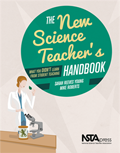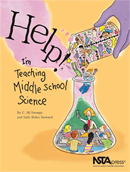Book Beat: August 2016
By Lauren Jonas, NSTA Assistant Executive Director
Posted on 2016-08-14
Tips for the First Days of School
From engaging first-day activities to tips for setting a positive and supportive tone in science class, teacher-to-teacher advice is like Olympic gold at this time of year. NSTA Press authors offer lots of strategies and ideas to help you start the school year off right. Download these chapters and add them to your classroom tool kit this fall. Best wishes for the new school year from all of us at NSTA Press!
Start the Year Off Right
 Authors Linda Froschauer and Mary L. Bigelow offer excellent guidance for novice and experienced science teachers in their book Rise and Shine: A Practical Guide for the Beginning Science Teacher. From classroom management ideas to suggestions on best ways to support all learners, the chapter “Creating an Environment for Learning” offers practical advice to help you set the stage for learning and exploration right from the start.
Authors Linda Froschauer and Mary L. Bigelow offer excellent guidance for novice and experienced science teachers in their book Rise and Shine: A Practical Guide for the Beginning Science Teacher. From classroom management ideas to suggestions on best ways to support all learners, the chapter “Creating an Environment for Learning” offers practical advice to help you set the stage for learning and exploration right from the start.
 In The New Science Teacher’s Handbook: What You Didn’t Learn From Student Teaching, Sarah Reeves Young and Mike Roberts pack in a wealth of teaching tips and strategies on topics ranging from lab safety to classroom setup and supplies. Download the chapter “Starting Class the Right Way: Starter Activities” for four great ways to begin class. Your students will be energized and engaged from the first moments of class.
In The New Science Teacher’s Handbook: What You Didn’t Learn From Student Teaching, Sarah Reeves Young and Mike Roberts pack in a wealth of teaching tips and strategies on topics ranging from lab safety to classroom setup and supplies. Download the chapter “Starting Class the Right Way: Starter Activities” for four great ways to begin class. Your students will be energized and engaged from the first moments of class.
 Also check out “The First Day,” a chapter from C. Jill Swango and Sally Boles Steward’s book Help! I’m Teaching Middle School Science that provides 10 opening-day icebreaker activities sure to capture the attention and imagination of your newest student scientists.
Also check out “The First Day,” a chapter from C. Jill Swango and Sally Boles Steward’s book Help! I’m Teaching Middle School Science that provides 10 opening-day icebreaker activities sure to capture the attention and imagination of your newest student scientists.
We Are All Scientists Here
 For elementary students, valuable activities for the first days of school include exploring what scientists do and observing and recording observations, skills that come into play throughout the year in science class. “Scientists Like Me” from Inquiring Scientists, Inquiring Readers: Using Nonfiction to Promote Science Literacy, Grades 3–5, by Jessica Fries-Gaither and Terry Shiverdecker, will open your elementary students’ eyes to who can become a scientist (they can!) and several key science practices.
For elementary students, valuable activities for the first days of school include exploring what scientists do and observing and recording observations, skills that come into play throughout the year in science class. “Scientists Like Me” from Inquiring Scientists, Inquiring Readers: Using Nonfiction to Promote Science Literacy, Grades 3–5, by Jessica Fries-Gaither and Terry Shiverdecker, will open your elementary students’ eyes to who can become a scientist (they can!) and several key science practices.
 For secondary students, check out “The Owls and the Snakes (1)” in Daniel Levin and coauthors’ Becoming a Responsive Science Teacher: Focusing on Student Thinking in Secondary Science. This chapter introduces a real-life mystery about blind snakes and screech owls that will launch your students on a quest for answers while boosting their scientific argumentation skills.
For secondary students, check out “The Owls and the Snakes (1)” in Daniel Levin and coauthors’ Becoming a Responsive Science Teacher: Focusing on Student Thinking in Secondary Science. This chapter introduces a real-life mystery about blind snakes and screech owls that will launch your students on a quest for answers while boosting their scientific argumentation skills.
Participants in the NSTA Learning Center’s discussion boards this month are having a lively exchange of ideas for icebreaker activities in the classroom, including a group assignment to design a vehicle with limited materials and a first-day activity to draw a scientist and explore what scientists do. Why not add your own ideas for your favorite activities to help keep the teacher-to-teacher conversation going?
And the Medals Go to …
NSTA Press authors and staff have been honored with numerous awards for teacher and student books on topics ranging from environmental science to solar science and lab activities in life science. Visit the NSTA teachers awards page to learn more about the books receiving all the buzz. You might find your next “gold medal” classroom resource for a successful new school year.
NSTA’s Book Beat is also emailed as a monthly e-newsletter designed to keep NSTA Press® readers, and the wider audience of science teachers, informed about books and teacher resources available through the National Science Teachers Association. Each month’s issue highlights selected topics in science education and new content in NSTA Press books with links to free sample chapters and lessons. NSTA’s Book Beat also informs readers of special offers and discounts available through the NSTA Science Store. Click here to view past issues or to sign up to receive future issues.
Follow NSTA
Disclaimer: The views expressed in this blog post are those of the author(s) and do not necessarily reflect the official position of the National Science Teaching Association (NSTA).



